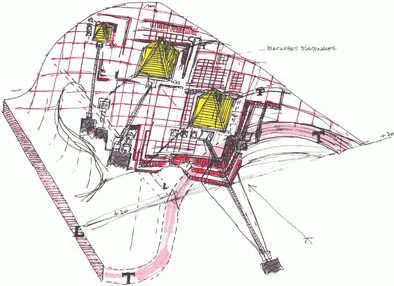Part 1 – General presentation
In 1997, put on the web a first site entitled: "CONSTRUCTIVE SYSTEM OF PYRAMIDS General presentation ", with the collaboration of B. THIEL / IPGP / University P. & M. CURIE, Paris-VI.
ORIGIN OF MATERIALS
The blocks of limestone constituting the body of the pyramid, according to our postulate, are taken from the plateau of Giza, at the closest, by directly exploiting the horizontal stratums of the plateau:
- The verification of the conformability of the stone from the plateau of Giza (Lutetian, medium-eocene, Nummulitic limestone) with the three Great Pyramids, and the spotting by aerial views of the exploited areas can easily be performed,
 |
 |
 |
| Remains of the quarries at the foot of Kephren . . . | and at the N.W. corner of Mykerinos (covered in sand) |
- The remains of the quarries are visible by the foot of Khephren and Mykerinos
[18]Note [18] - Remains of quarries that it is impossible to deny and necessary to integrate in any schema of explanation.
(covered in sand). From a geological standpoint, the plateau of Giza constitutes of specific limestone - medium-eocene, Nummulitic - and is, by tectonic deformation, a slight anticlinal fold that has obviously caused an easily analysable (double) system of fracturing of the natural rock
[19]Note [19] - Scientific Geological Bulletin - Researches on the natural fracturing of rock 1969-1972. “Method to study the natural fracturing of rock associated with a variety of structural models” by Michel RUHLAND. Research team associated with the CNRS “Structural Geology and tectonic analysis”. Institute of Geology at Louis Pasteur University, Strasbourg. Contradicting what can have been said or written by some renown Egyptologists, the three Great pyramids are not located according to the Dog constellation, neither is their orientation determined by the heliacal rise of Sirius. The axis of the fold, determined by the presence of the great faults, is NE-SW, which results in the fact that the diagonal diaclases and therefore the pyramids will be oriented NS and/or EW.
:
- a first system of large fractures (open diaclases and faults, very easy to find) that are parallel and perpendicular to the axis of the tectonic fold and caused by the flexion,
- ua second system of sub-orthogonal, tight fractures (closed diaclases, denser and thinner, less visible) that are diagonal, on the left and on the right, to the axis of the fold and are also caused by compression.
Schema of the system of the natural double fracturing of the rock on the Giza plateau
 |
Nowadays like in the old days, no one can ignore the orientation, the geometry, and the frequency of this fracturing system at the risk of only extracting dog-eared, deformed or cracked blocks from the quarry, that would be difficult, if not to say impossible, to use.
- The extraction of the blocks, in a horizontal open-cast quarry, will be accomplished gradually depending on the needs, from the nearest and the most accessible places.Stratums are then cut up following a grid of trenches (of a man's width and orientated according to the thinner, diagonal fracturing system) that dictate massifs to be lift off : the “demissage”. The notches made in order to lift off the massifs are still visible on the ground of the quarries around the pyramids, on the remaining stratums and on some of the used blocks. This extracted massif will have to be cut once again (according to the fracturing system) in order to be moved and used, blocks being so to speak "pre-cut" in the quarries, they won't therfore require much trimming work afterward.


Aerial shot of Cheops' “temenos «, showing the primary transversal fracturing (perpendicular to the axis of the fold) and the quarry exploitation of the blocks according to the secondary fracturing (diagonal to the axis of the fold)
- the geologic map of Cairo and the area around Cairo shows the NE-SW orientation of the tectonic folding and of the faults at the edge of the plateau of Giza. As a result, the Pyramids of Giza are placed and orientated according to the geology and the rock natural fracturing:
- they are lined up along the top of the fold, parallel to the axis, where the stratums are quasi-horizontal, and therefore much easier to exploit,
- they are orientated N-E and E-W according to the fracturing - the thinnest - the metrical diaclases, themselves diagonal to the fold axis.
The rhomboidal shape of the Dashour-South pyramid doesn't come from a concern for making it lighter in order for it not to sink into the plateau, its construction follows the same system of “pyramidal growth” which allows to generate this shape. Couldn't the visible depression around
[20]Note [20] - See the aerial photography shot by Marilyn BRIDGES and published in her book “L'Égypte vue du ciel” p 40. (1996)- Éditions du Seuil.
the pyramid be the remains of the area of extraction the quarry of the same materials it is made of? (This hypothesis needs to be verified).





